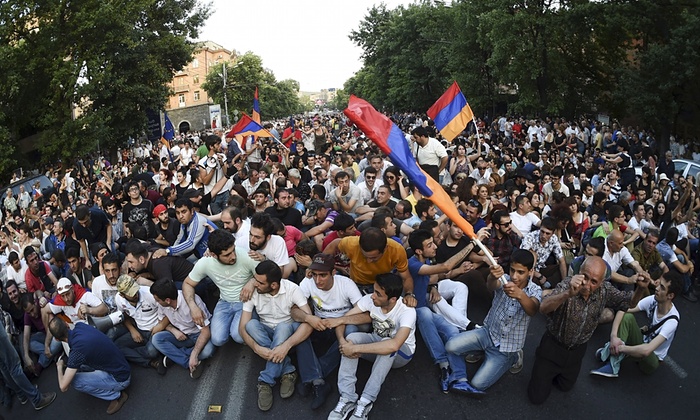
The Protests and Energy Interdependence in Armenia: View From Baku
Publication: Eurasia Daily Monitor Volume: 12 Issue: 126
By:

The protests in Yerevan against rising electricity prices have sparked a debate over the motives, expectations, and impact of this public outcry (see EDM, June 27). Energy shortfalls and crises have long been a sensitive subject for Armenia due to the painful experiences of energy shortages in the 1990s. The current protests, however, speak to a wider range of social concerns that are largely independent of any foreign policy–related political agenda. In other words, the protesters are neither “anti-Russia” nor focused on finding alternatives to dependence on Russian energy supplies.
During the past two years, the Armenian government has sold the decision to join the Eurasian Economic Union (EEU) based on security guarantees (relating to the Karabakh conflict) and the economic benefits EEU membership would ostensibly bring. However, contrary to those expectations, the energy price hike and ensuing demonstrations reflect a growing public examination of Yerevan’s overdependence on Moscow. The protest is not yet anti-Moscow in character, because the Armenian government is keen to avoid that narrative. The protest actually appears to have strengthened President Serzh Sargsyan’s hand—a few days after the protests, Russia declared it would provide Armenia with a soft loan of $200 million for the purchase of modern weapons. Moreover, after months of fruitless negotiations with Gazprom regarding cutting the price Armenia pays for Russian natural gas—from the current $189 to $165 per thousand cubic meters (Arka.am, March 30)—the two sides have suddenly reached an agreement that is supposed to come into force as of January 1, 2016 (Aravot.am, July 4). Also notable was the unexpected recent transfer to Armenian authorities of Valery Permyakov, who served at a Russian military base in Armenia and has been charged with the murder of a local family back in January 2015 (The Armenian Weekly, June 30; see EDM, January 16).
Although the protests over the electricity price hikes may have benefited the Armenian government in terms of having more leverage in negotiations with Moscow, the latest talks with Russia are yielding neither short- nor long-term solutions to Armenia’s energy issues. Indeed, Ara Marjanyan, the president of the Armenian non-governmental organization “E-Cube,” spoke on this subject, on June 20, at the North Atlantic Treaty Organization’s 89th Rose-Roth Seminar, in Yerevan. According to Marjanyan, the only way to improve Armenia’s energy security situation is through regional integration, which depends on the resolution of the Karabakh conflict with Azerbaijan. Marjanyan’s view is that the direct costs associated with Azerbaijan and Turkey’s energy and transportation blockade has cost Armenia approximately 20 billion euros ($22 billion)—the equivalent of three new nuclear power plants and one pumped storage hydro-electric power plant, or two new strategic railroads and the overall modernization of Armenia’s transportation network (NATO Rose-Roth Seminar, June 20).
Although Azerbaijan has previously stated its readiness to supply gas to Armenia contingent on Yerevan’s constructive approach to the Karabakh conflict resolution process (Today’s Zaman, June, 16 2013), recent events have not inspired such an offer this time.
Officials in Baku have described the Yerevan protests as political rather than social; Ali Hasanov, an aide on social and political issues to the Azerbaijani president, has spoken of a public “rebellion” against Armenian governance (APA, April 25). The Azerbaijani Ministry of Foreign Affairs went further, calling the demonstrations the result of the “militarized” nature of Armenia’s government. (News.az, June 26). But the major focus in Azerbaijan has been the perceived silence of Western institutions, the international media and human rights watchdogs over the June 23 police crackdown in Yerevan (see EDM, June 29)—especially when compared to the international criticism over Azerbaijan’s human rights record (Sia.az, June 25).
However, the biggest concern in Azerbaijan about the impact of the Yerevan protests is the possible intensification of military tensions around Karabakh; Baku fears that the Armenian government could now use “security reasons” to justify intensifying military operations along the line of contact. In particular, fearing that Baku will take advantage of Armenia’s domestic instability, Yerevan may decide to preemptively launch its own military operations (APA, June 27).
For now, military intensification in the region has not materialized: as the Yerevan protests continue to diminish in size, the possibility of a military intervention has also been decreasing. Moreover, the Yerevan energy protests have not, in fact, opened up a public debate on Armenia’s regional isolation, which has led to economic losses and energy insecurity. Nevertheless, even though the protests have calmed down, the worsening economic situation in Russia will pose a major short-term challenge to Armenia. Money sent back home by Armenians working abroad provides a means of basic survival for the majority of Armenian society, and an estimated 21 percent of Armenia’s economy relies on remittances, according to the World Bank (The Guardian, January 18). Reduced remittances from Russia could, therefore, have potentially catastrophic consequences. On this basis, this may not be the last public protest in Yerevan over the coming months.




